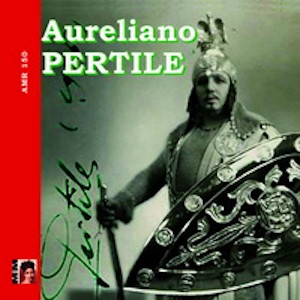
Aureliano Pertile (tenor)
Disques Columbia
rec. 1922-23 & 1932-33. Mono
Malibran-Music AMR150 [80]
Despite being Toscanini’s favourite tenor, Aureliano Pertile was not the possessor of an especially beautiful voice; indeed, while describing him as “a noble artist and a humble man…of superior interpretive intelligence” Lauri-Volpi pays him this rather back-handed compliment: “His ability to transform a somewhat quacking voice into artful modulations was most impressive….No other voice has ever been built of such truly dissonant material….he had succeeded in furnishing his voice with all the beauty, spontaneity and simplicity nature had denied him.”
This very well-filled compilation on the Malibran label combines the products of his two major recording spells for Columbia. He was a versatile artist, singing verismo, Wagner (in Italian, as per here) and, above all, Verdi – and although we have only two arias from La traviata here, he did in fact make an excellent complete recording of Aida in 1928 (see my survey). We finish with three Neapolitan songs.
As is immediately apparent from the first aria from Lohengrin, sung in Italian, and as I remark in my review of that Aida, “his fast vibrato and light timbre can sometimes be suggestive of a bleat, but the power and accuracy of his delivery soon dispenses any hint of the tenorino in his voice.” His legato is exemplary and if, as I observe in my review of his 1930 recording of Il trovatore, he “occasionally allows his vibrato to get away from him and produce the effect of singing sharp”, that is a rare occurrence. His delivery of aria from Andrea Chénier (track 3) is especially heartfelt and while his top notes – insofar as the acoustic recording allows us to divine – are not as ringing as those of successors Del Monaco and Corelli, they have plenty of power and passion. Conversely, he is boyish and charming in “Tra voi belle” from Manon Lescaut and indeed there is a total of four arias from that opera as it clearly suited him ; likewise, he easily conveys Alfredo’s impetuousness in the two arias from La traviata. Lauri-Volpi is right about the slightly odd timbre of his tenor – but also right about how he clearly cultivated such good vocal manners and honed his technique in order to render the nasality and lack of bloom in his tone negligible disadvantages. Likewise, his lack of physical allure as revealed by the five faintly comical photographs obviously did not hinder the success of his long career – albeit that he did not possess the matinée idol looks of the two aforementioned tenors – any more than it handicapped the short and squat Caruso.
The change to the recordings made a decade later but also reveal a darkening of his vocal colour and some perceptible loosening of his vibrato but the emotional weight and commitment of his delivery of two arias from each of Adriana Lecouvreur and Fedora are especially striking. He permits himself the occasional half-sob and gulp, edging towards the manner of Gigli but without compromising good taste. Two more arias from Lohengrin amply demonstrates how a true lyric tenor can do justice to Wagner’s long lines without any sense of being under-powered, nor do Pagliaccio’s histrionics over-stretch him – and then he demonstrates the pliant delicacy of his tenor by singing the comprimario Beppe’s serenade from the same opera. Then again, the power and security of his top notes are much in evidence in passages such as the conclusion to “O paradiso”, where he rises to a ringing B-flat. “Apri la tua fenestra” from Mascagni’s Iris is a comparative rarity and is here given the best and most rousing performance. The Tosca arias suffer a little from the essentially pinched quality of Pertile’s sound but are nonetheless compelling. The three songs make a pleasing coda to an otherwise fairly heavyweight programme.
Despite the anonymity of the conductors and orchestras, one is aware that their contributions throughout are excellent. No notes or recording information are provided beyond the bare minimum of the track titles as per below and the handful of photos – no timings, orchestras, conductors, nothing, not even the names of the composers of the operas from which the arias are taken – although I guess the average opera buff interested in Pertile will be mostly familiar with material here and not much care about the minimal presentation.
Ralph Moore
Availability: Malibran-Music
Contents
1922-23
01 – Lohengrin: Sei torna alfin
02 – Pagliacci: Un tal giocco
03 – Andrea Chenier: Come un bel di maggio
04 – Manon Lescaut: Tra voi belle
05 – Manon Lescaut: Ah! manon, mi tradisce
06 – La Traviata: Dei miei bollenti spiriti
07 – La Traviata: Scène de la bourse
1932-33
08 – Mefistofele: Dai campi, dai prati
09 – Mefistofele: Giuto sul passo estremo
10 – Adriana Lecouvreur: La dolcissima effige
11 – Adriana Lecouvreur: L’anima ho stanca
12 – Lohengrin: Di, non ti incantan
13 – Lohengrin: Da voi lontan
14 – Pagliacci: Recitar… vesti la giubba
15 – Pagliacci: O Colombina
16 – Fedora: Amor ti vieta
17 – Fedora: Vedi, io piango
18 – L’Africaine: O paradiso
19 – Cavalleria rusticana: Addio alla madre
20 – Manon Lescaut: Donna non vidi mai
21 – Manon Lescaut: Ah! non v’avvicinate
22 – Iris: Apri la tua finestra
23 – Tosca: Recondita armonia
24 – Tosca: E lucevan le stelle
25 – Musica proibita
26 – Maria, Mari
27 – O sole mio


















